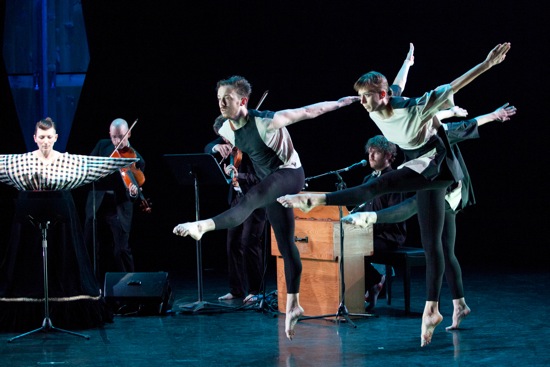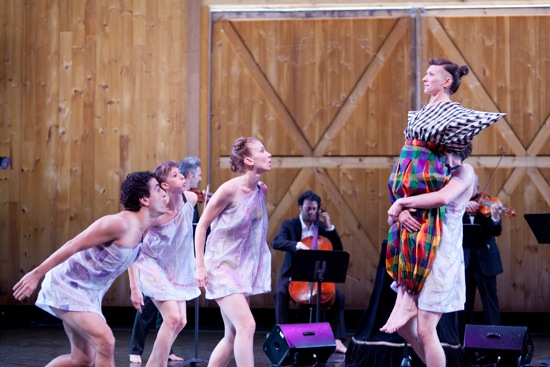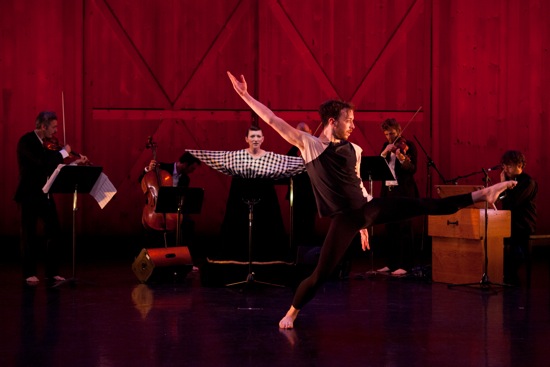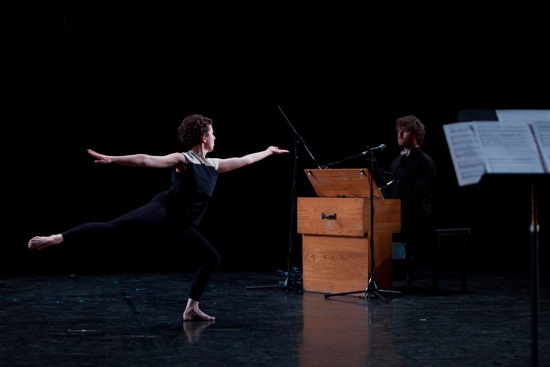John Heginbotham premieres his full-evening Chalk and Soot at Jacob’s Pillow.

John Heginbotham’s Chalk and Soot.
Foreground: Weaver Rhodes (L) and Lindsey Jones. Visible at back (L to R): Shara Worden, Nicholas Cords, Gabriel Kahane. Photo: Jamie Kraus
No artist can entirely escape history. Unacknowledged, it trails behind him/her. Occasionally it blows around the artist’s ankles, occasioning thoughts. What was that? Where did I get it? Is it something barely remembered or something better chopped off? John Heginbotham doesn’t deny the influences of his years with the Mark Morris Dance Group. His new Chalk and Soot is strikingly original, but it has a kind of robust precision and a relationship to music that he shares with Morris.
Also, since part of Chalk and Soot premiered in 2013 as part of Carolina Arts’ centennial celebration of The Rite of Spring, it’s not too big a shock when, in the full-evening piece that debuted at the Jacob’s Pillow Dance Festival, wisps of Stravinsky’s melodies and pounding chords surface—shrewdly disguised—in Colin Jacobsen’s score for the group Brooklyn Rider. Nor is it too odd that in Part II, the dancers temporarily shuck their black, gray, and white costumes (by Morris dancer Maile Okamura) and appear in short, flowy, bare-shouldered tunics, whose faintly mottled, flesh-colored surfaces call to mind the dirt-soiled dresses in Pina Bausch’s Rite of Spring.

(L to R): John Eirich, Lindsey Jones, and Sarah Stanley (who alternated with Courtney Lopes) blowing; Shara Worden held up by Weaver Rhodes; visible at back: Eric Jacobsen. Photo: Jamie Kraus
The Russian-born Expressionist painter Wassily Kandinsky published a book of poems in 1912 (who knew?), whose eccentric structures and subjects recall the vogue for automatic writing and surreal imagery. Nine of those prose-poems, set to music by Jacobsen and sung by the remarkable Shara Worden, link Heginbotham’s postmodern work with decades-ago experimentation in the arts. And Nicole Pearce’s vivid lighting ignites a recollection of Kandinsky’s theories about the emotional and spiritual affect of colors.
Chalk and Soot gears up slowly. For a while we sit contemplating a stage devoid of people; only four music stands, two chairs, and a small reed organ populate the Doris Duke Theater’s performing area. Yet we hear scraps of sound made by unseen instruments. Whistling? Groaning? A bow scrapes across a couple of strings, creating an uncanny whisper, a suppressed howl; fingers tap against wood. Silence. Then the noises start up again. Eventually they resolve themselves into something more musical. But the only person who appears on stage is dancer Lindsey Jones, who executes a long solo in silence, after which the first musician, Gabriel Kahane (reed organ and vocals), and takes his place.
Jones, you later discover, is laying out some of the movements that will recur throughout the piece and, more importantly, its prevailing dynamic. Clear and strong in everything, she does, she hits most of the steps and gestures as if they were ejaculations—little shouts. Occasionally, she draws out or suspends a moment, but most frequently her dancing emerged in a soft-spoken staccato. Hit and hold. Often she presents the movement to us, staring gravely in our direction.
Finally the other musicians—all wearing shiny, floor-length gray coats—enter one by one: composer Jacobsen (violin), Johnny Gandelsman (violin), Nicholas Cords ((viola), Eric Jacobsen (cello), and. What they play during Act I of Chalk and Soot is spare for the most part; sounds spurt out, die, blurt a fragment of melody, shiver, rage into tremolo. At one point the players exhale rhythmically; at another, they line up and intone text.
Gradually, the remaining four dancers appear (Macy Sullivan, Courtney Lopes, John Eirich, and Weaver Rhodes), and their shared vocabulary reveals itself. Small Sullivan runs through some of the moves that tall Jones has introduced—only faster. Some of the steps show off recognizable dancerly traits: legs lifted high and straight, pointed toes, etc. But also featured are hands flexed at the wrist, semaphoring intricately, and all manner of quirky moves. For instance, the two men (Eirich and Rhodes) enter crawling on their knees and forearms. When Jones has finished her initial solo, she starts to exit, then stops and bends forward from her hips, with her head and shoulders offstage. Later others will do this, or lie prone, half onstage, half off, and get dragged out of sight. Don’t be lulled; expect the unexpected.
As the excellent dancers come and go, joining in unison passage or separating into individual outbursts, certain steps become familiar—for instance, one person jumping into another’s arms, curled up like a needy infant. Or someone tracing the outline of a colleague in the air. Some images are sparky, like children’s games for grownups. Others are bizarre: Jones and Eirich, arms around each other’s shoulders, travel sideways facing us. Rhodes’s face appears between them at the level of their waists as he lopes along with them.
Sometimes Heginbotham pops in a visual image for the words that Worden is singing—not always at the same time that she delivers them. Kandinsky’s ‘Sounds” tells of a woman leading a very young calf by a rope: “Sometimes the calf walks very obediently and sometimes it doesn’t.” I attach this to a recurring image in Chalk and Soot: one dancer walks, holding a flex-wristed hand behind; another dancer bends to place his/her cheek on that hand and, in that position, they walk along together. Later a reference to pecking birds emerges: one person stabs another’s brow with pointed fingers. Pointing fingers, clapping hands, repeated references to eyes, and “disappearing slowly” all poke up in the choreography, refined into motifs.
After the post-intermission Part II, we finally get to meet the singer, and she’s quite a sight. She stands before a microphone, with the musicians now in a semi-circle behind her and four of the dancers, their backs to us, creating a curved barricade between her and the audience. Worden’s arms are (for the time being), hidden, while her black-and-white bodice is artificially elongated horizontally to look like wings. It’s a shock when she steps it from behind what turns out to be a stand-alone black skirt. Suddenly she’s a vision of color among the others in their monochromatic clothes. The rest of her outfit, in brilliant plaid, is neither harem pants nor a skirt; it’s a draped bag with holes for her feet. When she wishes to move, she toddles.

Shara Worden sings to Weaver Rhodes (foreground) in Part II of Chalk and Soot. At back (L to R): Colin Jacobsen, Eric Jacobsen, Nicholas Cords, Johnny Gandelsman, Gabriel Kahane. Photo: Jamie Kraus
Her voice is also colorful. She can drop her pure, warm soprano into sprechstimme or a conversational tone, and in this half of Chalk and Soot, the music (terrific, and a major part of the piece) yields more to melody. Sometimes, when Kahane’s organ sounds like an accordion in a dance hall, we might almost be ready for a Brecht-Weill cabaret moment.
One endearing thing about Worden is her curiosity about the dancers. She eyes them like a mother bird keeping track of some unruly just-hatched nestlings. They are often watchful too.It’s as if they’re wondering what’s in store for them.
Visions of death–a person laid out like a board across another’s arms—and ritualistic games materialize, perhaps in honor of Rite of Spring. The dancers clump together and join their high, pointing fingers. They hold hands in a line and somersault toward us. And they continue to remind us of the moves we’ve memorized from Part I.
Heginbotham and his colleagues have engineered a fascinating work; its edge of mystery mingles intriguingly with its antic touches and sharp-edged dancing. In Chalk and Soot, they are abetted by Pearce’s lighting. What is the significance of the glowing green diamond that the back curtains part slightly to reveal? Why is everything suddenly red? Are we inside a painting? History slides into layers, then melts a bit.


How lovely to see an image of Macy Sullivan, who trained at the School of Oregon Ballet Theatre, before going to Juilliard, one of the most intelligent and precise dancers to come out of that School, but much too tiny for a career in ballet. I did, actually, know about Kandinsky’s volume of poems, and I am very much intrigued by the description of how they are used in “Chalk and Soot,” a work I hope will tour to somewhere in my neighborhood in the Pacific Northwest. Thanks Deborah, comme toujours, for your seductive prose.